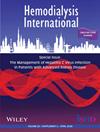A phase 3b, multicenter, open-label, single-arm study of roxadustat within a US dialysis organization: The DENALI study
Abstract
Introduction
Roxadustat is an oral hypoxia-inducible factor prolyl hydroxylase inhibitor approved in several regions for the treatment of anemia of chronic kidney disease (CKD). DENALI, a phase 3b study, evaluated the efficacy, safety, and feasibility of roxadustat in patients with anemia of CKD receiving in-center or home dialysis.
Methods
Eligible patients received open-label roxadustat, dosed three times weekly for 24 weeks, with an optional extension of ≤1 year. Initial dosing depended on erythropoiesis-stimulating agent (ESA) dose at screening for patients receiving ESAs (≥6 weeks) and weight-based for those not (total <6 weeks). Primary efficacy endpoints were proportion of patients with mean hemoglobin (Hb) ≥10.0 g/dL averaged over Weeks 16–24, and mean Hb change from baseline to the average during Weeks 16–24. Treatment-emergent adverse events (TEAEs) and treatment-emergent serious adverse events (TESAEs) were assessed.
Findings
Of 281 patients screened, 203 were treated and 201 included in the full analysis set. Overall, 166 patients completed the 24-week treatment period and 126 continued into the extension period. Mean baseline Hb was 10.4 g/dL and 82.6% received in-center hemodialysis. Overall, 84.6% of patients achieved a mean Hb ≥ 10.0 g/dL averaged Weeks 16–24. Mean (standard deviation) Hb change from baseline averaged Weeks 16–24 was 0.5 (1.0) g/dL. Prespecified subgroup analyses were consistent with primary analyses. Dosing adherence was 94%. Overall, 3.0% of patients received a red blood cell transfusion at up to Week 24. TEAEs and TESAEs were reported by 71.4% and 25.6% of patients, respectively. The most frequently reported TESAEs were COVID-19 (n = 5; 2.5%), and acute myocardial infarction, pneumonia, and sepsis (each n = 4; 2.0%).
Discussion
Roxadustat effectively achieved and/or maintained mean Hb levels ≥10.0 g/dL in patients receiving dialysis. The feasibility of incorporating oral roxadustat into dialysis organizations was successfully demonstrated with high dosing adherence. No new safety signals were identified.


 求助内容:
求助内容: 应助结果提醒方式:
应助结果提醒方式:


